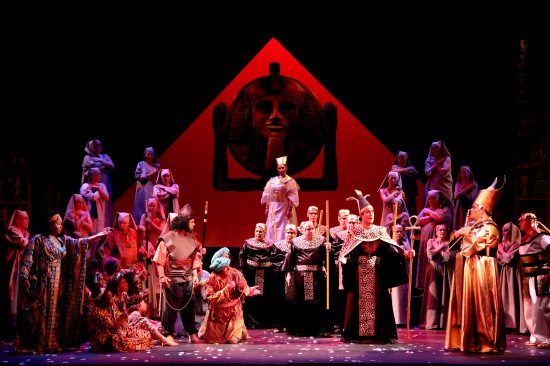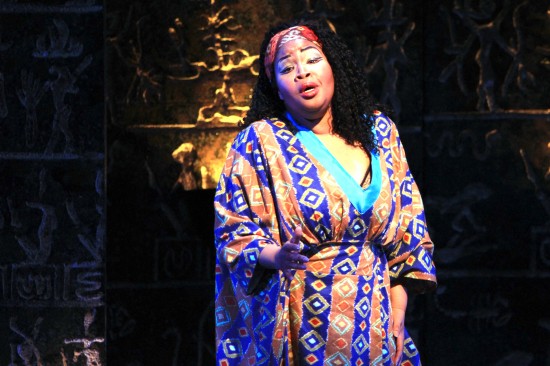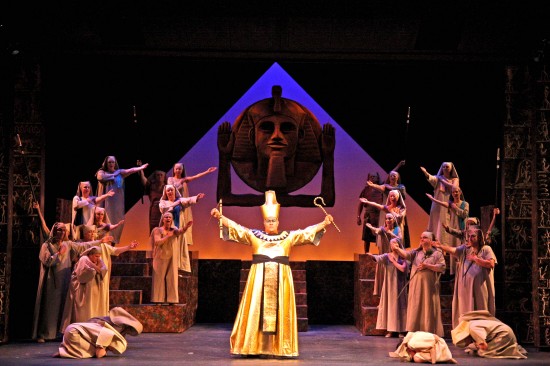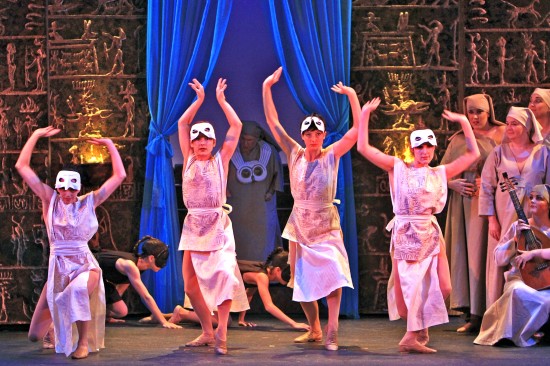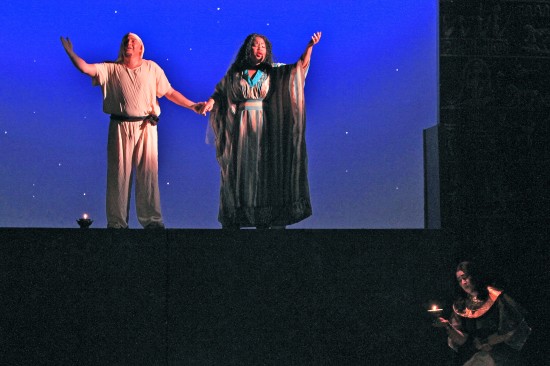Last night, Friday May 25, 2012, I saw my third different production of Aida in three years. In a sense, I can honestly say that each of them is the “best” that I have ever seen: The MetHD in 2009 was the best HD, San Francisco Opera in 2010 was the best large-theatre, and last night’s West Bay Opera was the best small-theatre.
You know the “word-association” party game? The leader calls out a word and each guest is to write down the word that they first associate with it. Well, if a group of casual opera-goers were to play this game and be given the word “Aida”, I suspect that a substantial number of them would respond, “Elephants”. Indeed, Met Opera productions of the 1930s as well as productions in Egypt and in Rome have actually had live elephants on stage for the triumphal march – and the 2010 San Francisco Opera had a wonderful artificial representation of a gigantic elephant.
But the triumphal march is but one scene in a three-plus hour performance. Aida is also an intimate story of four people: Aida (Karen Slack), Radames (David Gustafson), Amneris (Cybele Gouvenneur), and Amonasro (Doug Botnick), each with an inner conflict between love and patriotism.

Amonasro is the least complex of the four. He is the King of Ethiopia and the father of Aida, but when paternal love comes into conflict with love of country, he is emphatic in his choice of the latter: “You are no daughter of mine!”
The other three form the eternal triangle – with complications. Both women are passionately in love with Radames who passionately loves only Aida. But Amneris is the all-powerful only child of the Pharaoh and Aida is her slave, captured in the previous war between Egypt and Ethiopia. Events reach crisis stage when Radames returns victorious from the war with Ethiopia and the Pharaoh “rewards” him with the hand of his daughter in marriage.
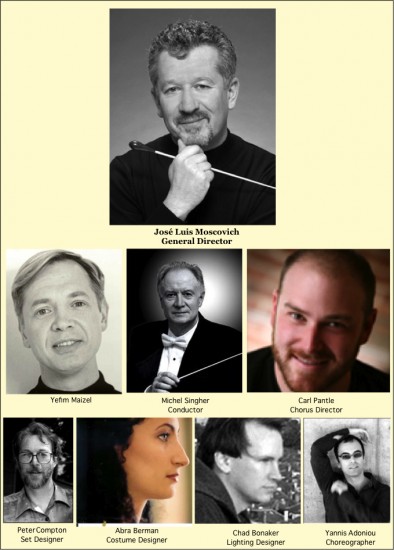
Production Team; photos: Chad Bonaker, Stanford Arts; Carl Pantle, Gay Men's Chorus; all others, West Bay Opera
Out of such stuff is great drama created – and West Bay Opera rose to the challenge of creating it. The singing and acting of the performers, the vision of Director Yefim Maizel, the sets of Peter Compton, the lighting of Chad Bonaker, the costumes of Abra Berman, the conducting of Michel Singher, the chorus under the direction of Carl Pantle and the choreography of Yannis Adoniou all came together to create a masterpiece. And don’t forget the master-mind behind it all, General Director JosÉ Luis Moscovich. He had the daring to schedule Aida, gambling that it could be done, despite the limitations of space and money; and the skill, knowledge, and salesmanship to hire all of the above – and most important, they were all in balance with each other and with the venue, Lucie Stern Theatre.
Let me, for a moment shed my Opera Nut hat for the cap and gown of my former career as a professor of engineering. Lucie Stern Theatre has approximately 400 seats compared with about 3,000 at War Memorial Theatre, home of San Francisco Opera – as I recall, about 2,400 of those are in the orchestra: a ratio of 6 to 1. WBO’s production of Aida had an orchestra of 22 and a chorus of 32 – the numbers for SFOpera are 84 and 80, so the ratios are approximately 4 to 1 and 2.5 to 1. Granted that SFOpera can probably attract singers with the capacity to produce louder sounds, I doubt that they could double it. And this factor is more than compensated for by the SFOpera’s ceiling being at least three times higher. Therefore, it is not surprising if the quantity of high quality music reaching an individual member of the audience is substantially greater in the smaller theatre.
And indeed, that was the case. In San Francisco I had no complaints. I felt surrounded by great music. But in Palo Alto I was immersed – I was saturated – the music came not only through my ears but through every pore in my skin – I felt it in my very bones. This was not only during scenes with full chorus. I felt it when any one of the triangle was singing a solo aria and really let loose. It was a wonderfully overwhelming sensation.
I want to particularly single out Karen Slack’s singing. Not only could she belt it out with the best of them, but when the music called for pianissimo, she could maintain a purity of tone down to the sound of a whisper and still project it over the whole house.
I should also mention two minor roles that were particularly well done. Carlos Aguilar has been in the last seven WBO productions. His formidable size and great bass voice made him an ideal choice for Pharaoh.
I had seen bass-baritone Isaiah Musik-Ayala in many roles with Opera San Jose, most recently as Baron Duphol in La Traviata; he proved a great choice of the stern role of High Priest.
The opera was staged with only one intermission – between Acts II and III. The transmissions between the other Acts and between Scenes were all handled seamlessly and so efficiently that they were not even classified as “pauses”. Two scenes in particular are worth mentioning. The Victory Scene which closes Act II has the famous Triumphal March as well as a lot of other glorious orchestral music. The classic Met production of the 1930s used all of this time for their famous parade of plunder and captives, showing cart after cart after cart of all sorts of spoils of war. More recent productions, including those by SFOpera and the current WBO have replaced most of the carts by dancers or other forms of entertainment. The dancers included four young dancers from Western Ballet and four dancers from KUNST-STOFF Dance Company, all choreographed by the latter’s Yannis Adoniou, two of whom we had seen earlier in the season in WBO’s Samson and Delilah.
Unrelated to the imaginative dancing, my one small complaint about the opera presentation was at the beginning of this scene. I liked the fact that as a crowd of townspeople gathered to celebrate the victorious return of the army they were a noisy bunch with an increasing volume of spontaneous cheers for each herald or soldier that entered. Unfortunately, this cheering almost completely drowned out the stirring Triumphal March, which is one of my favorite musical pieces in all opera (way back when I was a teenager I used to pound out a spirited piano transcription of the march). Since the obvious solution (hire several more brasses) is probably not practical from either a financial or spatial viewpoint, I hope the director will keep the enthusiasm but tone down the volume of the cheering masses in future performances.
The other scene is the final entombment scene. The staging here was done with magnificent restraint. The curtain rises to reveal nothing but pure black. Suddenly Radames appears, holding a candle whose natural light is enhanced by a bit of judicious spot-lighting. The lighting not only lets us see Radames (and later, Aida), but it also defines a small rectangular box. The whole effect is strikingly claustrophobic.
As we near the end of their beautiful final love duet, a small opening in the traditional Egyptian triangle shape appears on the back wall of the “box”, revealing a small portion of starry sky. The triangle grows to show more and more starlit sky, and the side drapes draw back until the entire back of the stage is starlit – claustrophobia has been replaced by infinity.
Meanwhile the spot-lighting is slowly reduced until the two entwined (and always singing) figures are reduced to silhouettes. The overall lighting slowly fades and the singing gets imperceptibly quieter until eventually all is darkness and silence.
All is darkness and silence . . . . Until . . . .
The audience bursts into wild applause.
Lucie Stern Theatre
Palo Alto CAӬ 94306
1305 Middlefield Road
650.424.9999
Except as noted otherwise, all photos by Otak Jump
P. S. The final two performances will be next weekend – Saturday June 2 at 8:00 pm and a Sunday matinee at 2:00. If you come Saturday, drop by seat E2 during intermission and say “hello”.
Thus ends WBO’s 2011-12 season. The excitement will continue next year with Offenbach’s Tales of Hoffmann in October, Donizetti’s Lucia di Lammermoor in February, and Verdi’s Otello in May-June. Season tickets go on sale July 2.
This review by Philip G Hodge appeared in sanfranciscosplash.com on May 29, 2012.

